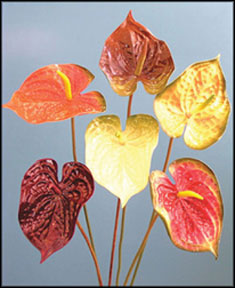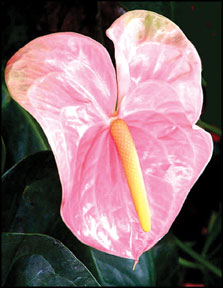Flowers and Pets
Compiled by Damayanthi Hewamanna
Anthurium The Flamingo Flower or Boy Flower:
 |
|
Red
Anthurium |
 |
|
A
combination |
Anthurium is a large genus of about 600- 800 species, belonging to
the arum family. Anthurium can also be called "Flamingo Flower" or "Boy
Flower", both referring to the structure of the spathe and spadix.
It is one of the largest and probably the most complex genus of this
family; certainly it is one of the most variable. Many species are
undoubtedly not yet described and new ones are being found every year.
The species has neotropical distribution; mostly in wet tropical
mountain forest Central America South America but some in semi-arid
environments. Most species occur Panama Colombia Brazil Guiana Shield
and Ecuador.
According to the work of noted aroid botanist Dr. Tom Croat of the
Missouri Botanical Garden, this genus is not found in Asia. Some species
have been introduced into Asian rain forests, but are not endemic.
Anthurium grows in many forms, mostly evergreen, bushy or climbing
epiphytes with roots that can hang from the canopy all the way to the
floor of the rain forest. There are also many terrestrial forms which
are found as understory plants, as well as hemiepiphytic forms.
Hemiepiphyte
A hemiepiphyte is a plant capable of beginning life as a seed and
sending roots to the soil, or beginning as a terrestrial plant that
climbs a tree and then sends roots back to the soil. They occur also as
lithophytes. Some are only found in association with arboreal ant
colonies or growing on rocks in midstream. The stems are short to
elongate with a length between 15 and 30 cm.
The simple leaves come in many shapes; most leaves are to be found at
the end of the stems, although terrestrial plants show less of this
pachycaul tendency. Leaves may be spatulate, rounded, or obtuse at the
apex. They may be borne erect or spreading in a rosette, with a length
that may surpass 100 cm in some of the larger species (such as Anthurium
angamarcanum).
Features
 |
|
Pink
Anthurium |
The upper surface of the leaf may be matte, semiglossy, or fully
glossy, and the leaf texture may range from leathery to fragile and
papery.The leaves are petiolate and possess a structure called the
geniculum, which is unique to the genus Anthurium.
The geniculum allows the plant to swivel its leaves towards the sun,
much in the same manner as sunflowers. In drier environments, the leaves
can form a bird's-nest shaped rosette that enables the plant to collect
falling debris, and thus water and natural fertilizer.
Terrestrial growers or epiphytes often have cordate Anthurium flowers
are small (about 3 mm) and develop crowded in a spike on a fleshy axis,
called a spadix, a characteristic of the Araceae. The flowers on the
spadix are often divided sexually with a sterile band separating male
from female flowers.
This spadix can take on many forms like club- shaped, tapered,
spiraled, and globe-shaped and colors such as white, green, purple, red,
pink, or a combination of all of them.
The spadix is part of an inflorescence, the outer portion of which is
known as the spathe. The spathe may be a single color or possibly
multicolored including burgundy and red. Anthurium grown for the florist
trade generally have highly coloured spathes and spadices. The spathe
can vary in color from pale green to white, rose, orange or shiny red.
 |
|
White
Anthurium |
The color changes between the bud stage and the anthesis, thus the
color might change from pale green to reddish purple to reddish brown.
The flowers are hermaphrodite containing male and female flowers.
The fruits are usually berries with one to multiple seeds on an
infructescence that may be pendant or erect depending on species.
Anthurium berries may range in colour from bright red to black, and may
also be bicoloured or shaded.
The flowers of Anthurium give off a variety of fragrances, each
attracting a variety of specific pollinators. Several species are
popular in the florist trade as pot plants or cut flowers and for
interior decoration. They include forms such as A. crystallinum f
peltifolium with its large, velvety, darkgreen leaves and silvery white
venation.
Most hybrids are based on A. andreanum or A. scherzerianum because of
their colorful spathes. Anthurium can also be called "Flamingo Flower"
or "Boy Flower", both referring to the structure of the spathe and
spadix. Like other Aroids, many species of Anthurium can be grown as
houseplants, or outdoors in mild climates in shady spots.
They thrive in moist soils with high organic matter. In milder
climates the plants can be grown in pots of soil. Indoors plants thrive
at temperatures between 60-72 degrees and at lower light than other
house plants. Wiping the leaves off with water will remove any dust and
insects.
Plant in pots
 |
|
Pink and
Green combination |
Plant in pots with good root systems. Will benefit from a weak
fertilizer solution ever other week. In the case of vining or climbing
Anthuriums, the plants benefit from being provided with a totem to
climb. As with most Aroids, new plants can be grown by taking stems and
cuttings with at least two joints. Cuttings can be then rooted in pots
of sand and peat moss mixtures.
These pots then should be placed in greenhouses with bottom heat of
70-75 degrees. During the rooting process they should be kept out of
direct sunlight. Once rooted the plants can be transplanted to larger
pots or directly outside in milder climates. A second way to propigate
Anthurium is to take stem cuttings particularly from trailing varieties
and place them in water.
In four to five weeks the plant should develop roots and can be
transferred to pots. The final method is through direct planting of
mature seed or berries
We need homes
Kynsey, Lady and Didums have been sterilised and innoculated and are
in need of kind and loving homes.
They are house trained and are very loving and faithful and will make
excellent companions.
There are several cats too who need homes - they too have been
sterilised and neutered.
Animal lovers only - please call 0777585998.
Letter Corner
My Kalu:
| Chase it
away! It's a 'She'. She'll be a nuisance, oh what a curse!
The voices echo and reecho,
and glancing out of my window I saw a little black puppy,
wet and forlorn; with tear filled eyes that were searching
for love.
What devilish human hands
snatched you from your mothers bosom?
Lips still moist with your
mother's milk, left abandoned on the street,
to get run over? Is it?
Compassion, loving kindness
unheard of?
or unheeded?
Dear little Kalu, do not be
sad,
I will protect and keep you
under my wing
'Cos you are despised for
being born a 'SHE' and I am determined to help
because, I am also a 'SHE'.
Laki Rajapaksa, Minuwangoda.
|
The relationship between a man and a dog has been going back to
thousands of years equal to the population of street dogs in this
island.
The sorrowful state of love that we show for the most lovable
valentine animal is shocking in this part of the world.
The main thing is the economy of the country. When the country is
under a national crisis, the people in Colombo have some shocking
experience to care for dogs than they care for humans.
Some dogs travel in luxury vehicles for their hospitalization while
their counterparts look unsecured on the wayside exposed to risks of
accidents and victims of disease.
Hardly local authorities who are "expected" to look after and control
the dog population have no funds to launch a vaccination program for
street dogs.
The Vets in respective divisional areas lack the will to get the
local authorities to carry out an ambitious program to control the stray
dog population. This situation is worse in local authorities in suburbs
of Colombo with the lack of interest in Public Health Affairs.
We are to remind when the Public Health Work was well established
when the Department of Health Services undertook the responsibility of
local health care under the British and during the post independence era
so. Since the responsibility of the local authority was vested in the
local administration, hardly any methodical work seems to take place
without corruption or bribery.
It is very prudent that the local authorities do engage in
implementing the by laws and rehabilitate the dog population to control
rabies and other social misbehavior before things goes unchecked.
The CMC has now asked all people who have dogs to register them so
that they can keep a track of the dogs who are homeless and who have
homes.
Bandula Nonis
Resident of a town with a high dog population
Who’s a better mum?
 |
 |
 |
|
Elephant and her calf |
Gorilla
and her young |
Tigress
and her cub |
 |
 |
|
Weasle and her young |
Human and
her young |
|





